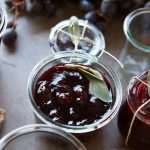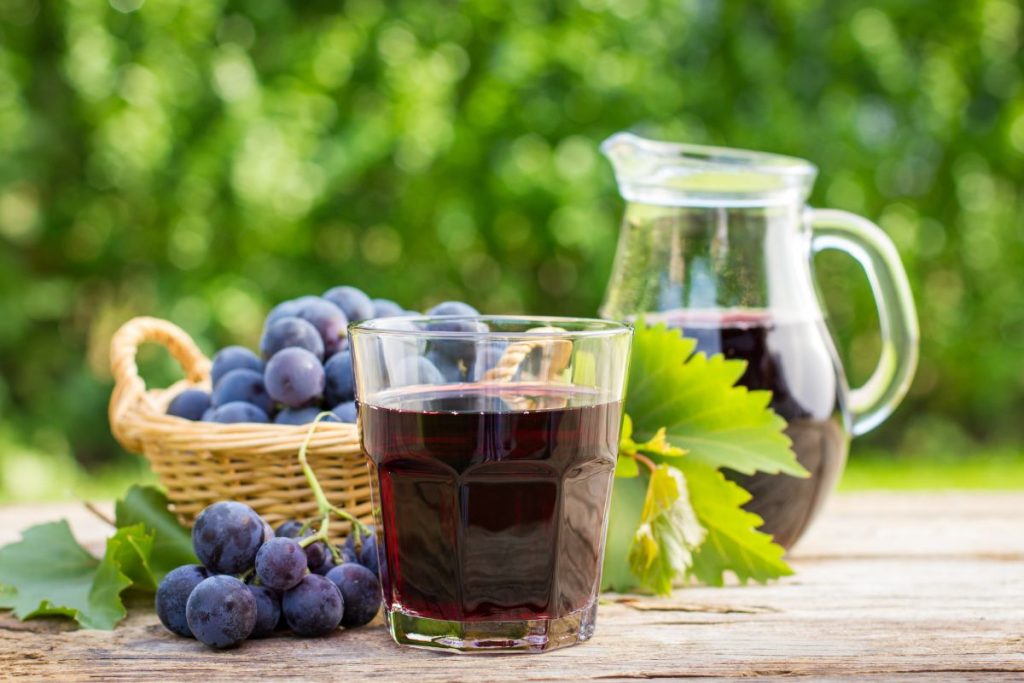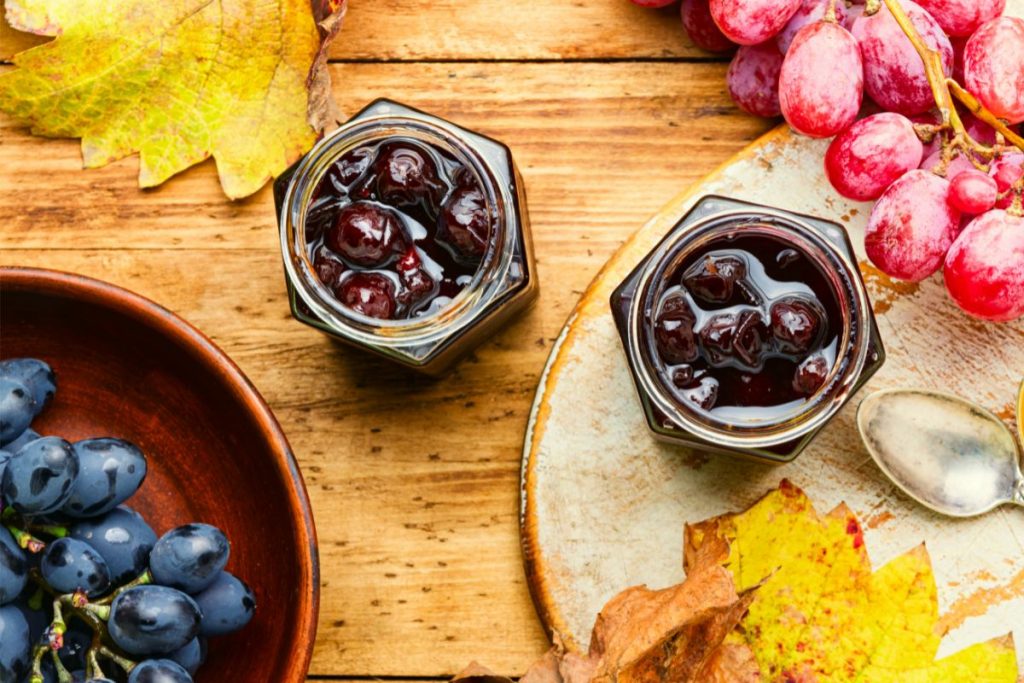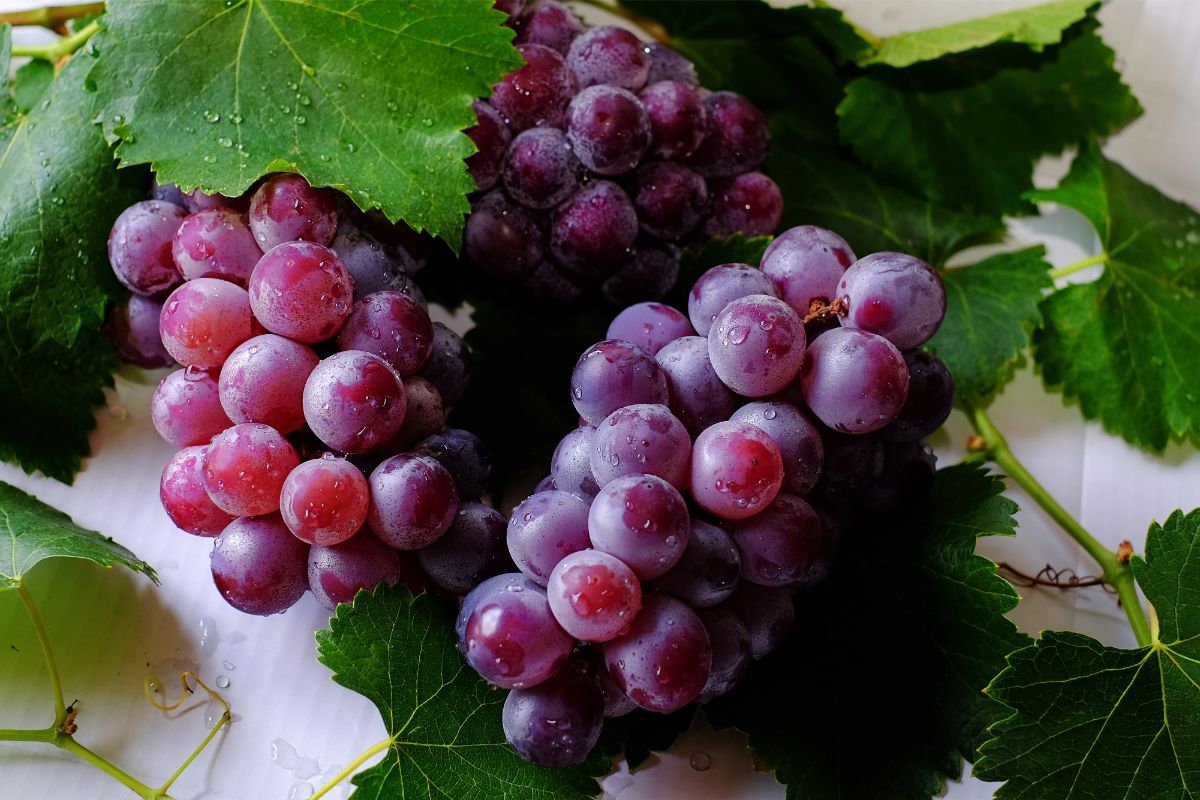Canning grapes begins by washing and removing the stems from the grapes before blanching them. Make a simple syrup by mixing sugar and water in a saucepan. Pack the blanched grapes and syrup into canning jars and process them in a boiling water bath canner.
What Is The Best Way To Preserve Fresh Grapes?
A boiling water bath canner is best when preserving high-acid foods with a pH below 4.6. Operating at 212°F at sea level, water bath canning effectively eliminates yeasts, molds, and bacteria. Moreover, the inherent acidity of grapes, with a pH between 3.5 and 4.5, prevents the growth of botulism bacteria, guaranteeing a safe preservation process.
Pressure canning is only necessary for grapes if you add low-acid ingredients or create a grape preserve with a higher pH level.
Print
Canning Fresh Grapes Recipe
- Total Time: 20 minutes
- Yield: 8 pints 1x
Description
Grapes taste great fresh, but there’s only so many you can eat at once. To preserve an abundance of grapes, try this canning recipe for beginners. This recipe guarantees the preservation of the flavors and textures of grapes so you can enjoy them all year!
Ingredients
- 8 pounds of grapes
- 1 cup sugar
- 8½ cups water
- Grape juice or apple juice (instead of water if desired)
Instructions
- Fill your water bath canner with at least two inches of water and set it on the stove using low heat.
- Sterilize your pint or quart jars by boiling them in soapy water or using the sterilize cycle on your dishwasher.
- Give your canning lids and bands a thorough cleaning with warm soapy water. Rinse well.
- Warm up your jars by placing them in the canner.
- Blend sugar and water in a saucepan to create a medium syrup. You can use boiling apple juice or white grape juice as a substitute.
- Begin the grape preparation process by washing and removing the stems.
- To hot pack the grapes, blanch the whole grapes in water for 30-60 seconds. Place the grapes into a saucepan filled with syrup, water, or juice and bring to a boil. Ladle the grape mixture into jars, leaving 1/2 inch headspace.
- To raw pack the grapes, fill the jars with raw grapes and add hot water, juice, or syrup, leaving a ½-inch headspace.
- Ensure there are no air bubbles in the canning jars by gently removing them with a wooden stir stick or bubble remover tool.
- Wipe the rims of the jars, securely place new canning lids on top of the jars, and screw the screw bands on until fingertip tight.
- Use a jar lifter to transfer the jars into the boiling water bath canner, setting them on the canning rack inside. Bring the water to a rolling boil, then cover the canner with a lid. Adjust the processing time per altitude, jar size, and packing method:
Hot Pack Water Bath Canning Grapes Processing Times
- 0 – 1,000ft: pints and quarts 10 minutes
- 1,001 – 3,000ft: pints and quarts 15 minutes
- 3,001 – 6,000ft: pints and quarts 15 minutes
- 6,001ft and up: pints and quarts 20 minutes
Raw Pack Water Bath Canning Grapes Processing Times
- 0 – 1,000ft: pints for 15 minutes and quarts for 20 minutes
- 1,001 – 3,000ft: pints for 20 minutes and quarts for 25 minutes
- 3,001 – 6,000ft: pints for 20 minutes and quarts for 30 minutes
- 6,001ft and up: pints for 25 minutes and quarts for 35 minutes
Post Processing
- Turn off the heat after the processing time and remove the canner’s lid. Leave the jars in the hot water in the canner for 5 minutes.
- Carefully lift the jars onto a surface protected by a clean towel using tongs or a jar lifter. Leave them to cool for 12 to 24 hours undisturbed.
- Test the seals by gently pressing the center of the lids with your thumbs to check for proper sealing. Any unsealed jars must be refrigerated and used within a week.
- Sealed jars should have screw bands removed, be cleaned, labeled with the contents and canning date, and stored in a cool, dry, dark place.
- Prep Time: 5 minutes
- Canning Time: 10 minutes
- Cook Time: 5 minutes
Nutrition
- Serving Size: 100g
- Calories: 73kcal
- Sugar: 19g
- Sodium: 5mg
- Fat: 0.1g
- Saturated Fat: .03g
- Carbohydrates: 20g
- Fiber: 0.6g
- Protein: 0.5g
- Cholesterol: 0mg
How Do You Make Grape Juice from Canned Grapes?
To make grape juice from canned grapes, follow these steps:
- Drain the canned grapes, reserving the liquid separately.
- Place the drained grapes in a blender or food processor and blend until smooth.
- Strain the blended grape mixture through a cheesecloth or fine mesh sieve to remove any solids or seeds.
- Combine the strained grape puree in a saucepan with the reserved liquid from the canned grapes.
- Add sugar or sweetener to taste and stir well to dissolve.
- Gently simmer the mixture over medium heat for a few minutes, stirring occasionally.
- Remove the pan from the stove and let the juice cool to room temperature.
- Once cooled, transfer the grape juice to a storage container and refrigerate.
- Serve chilled, and enjoy your homemade grape juice from canned grapes.

What Do You Use Canned Grapes For?
Canned grapes can be used in various delicious ways:
- You make canned grapes into delicious jam or jelly, perfect for spreading on toast or incorporating into pastries.
- Combine canned grapes with fresh fruits like pineapple, peaches, and mandarin oranges for a refreshing fruit salad.
- Blend canned grapes with yogurt, milk, and your favorite fruits to create nutritious smoothies.
- Use canned grapes to make a delightful homemade grape sorbet.
- Canned grapes can be transformed into a delectable filling for tarts or pies.
What Are the Benefits of Canning Grapes?
- Convenience: Canned grapes offer convenience as they are ready to use.
- Extended shelf life: Canned grapes have a significantly extended shelf life compared to fresh grapes.
- Nutritional value: Grapes are rich in vitamins C and K, antioxidants, and other beneficial compounds.
- Versatility: Canned grapes can be used in everything from salads to beverages.

How To Store Canned Grapes
- Choose a cool and dark area, such as a pantry or basement, for storing canned grapes with an ideal temperature between 50°F and 70°F.
- Ensure that the jars are properly sealed before storing them.
- Label the jars with the date of canning and the contents and organize them to allow easy identification and rotation, placing the oldest jars at the front.
- Avoid storing canned grapes in areas prone to extreme temperatures, such as near heating sources or direct sunlight, as it can affect the quality and safety of the product.
How Long Do Canned Grapes Last?
When stored properly, canned grapes have a shelf life of about 1 to 2 years. Be aware the quality of the grapes may gradually decline over time, so it’s best to consume them within the first year of canning.

